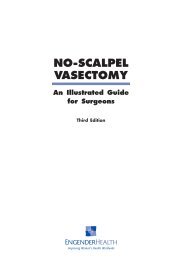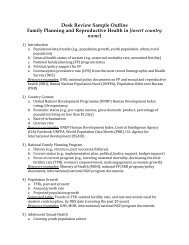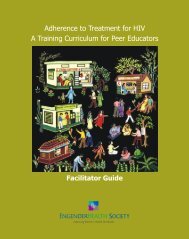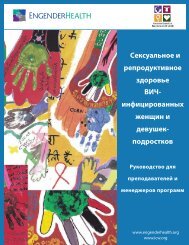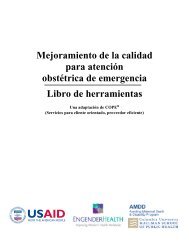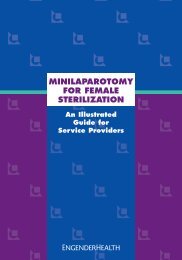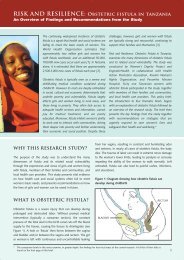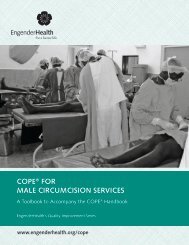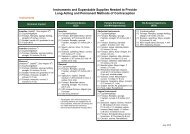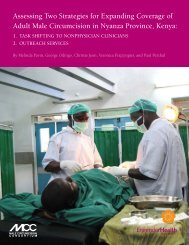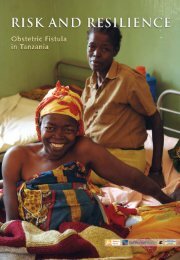Help-Seeking Pathways and Barriers for ... - EngenderHealth
Help-Seeking Pathways and Barriers for ... - EngenderHealth
Help-Seeking Pathways and Barriers for ... - EngenderHealth
You also want an ePaper? Increase the reach of your titles
YUMPU automatically turns print PDFs into web optimized ePapers that Google loves.
In addition to this large sample of KIIs, a total of 96 individuals (48 men <strong>and</strong> 48 women)<br />
participated in 12 PFGs (four groups per region). Recruitment of these participants was<br />
conducted by the team of trained researchers from UDSM in close consultation with local<br />
leaders once the selection of research sites was complete. Potential participants were<br />
invited by the field research team to participate in a discussion about violence in their<br />
communities. For both KIIs <strong>and</strong> PFGs, in<strong>for</strong>med consent was obtained by the research team<br />
prior to beginning each discussion, <strong>and</strong> the voluntary nature of participation was<br />
emphasized throughout the interview/focus group. In accordance with the in<strong>for</strong>med consent<br />
process <strong>and</strong> approved research protocol, the KIIs <strong>and</strong> PFGs were audio recorded.<br />
Recordings were transcribed into Kiswahili, <strong>and</strong> then all of the PFGs <strong>and</strong> a selection of KII<br />
recordings were translated into English.<br />
Notes were also taken by Research Assistants during the KIIs <strong>and</strong> PFGs using a<br />
st<strong>and</strong>ardized data summary <strong>for</strong>m to ensure consistency. The research team reviewed the<br />
summary <strong>for</strong>ms at the end of each day to assess the extent to which key themes had been<br />
addressed. If thematic gaps were identified, these themes were prioritized <strong>for</strong> subsequent<br />
interviews. Once all the data had been collected, the research team carried out analysis<br />
workshops to identify patterns <strong>and</strong> points of disagreement related to the key findings. This<br />
layered analysis allowed <strong>for</strong> iterative validation of the data within <strong>and</strong> across the sessions as<br />
well as the three target regions, <strong>and</strong> provided the foundation <strong>for</strong> the recommendations<br />
presented in Part IV of the report.<br />
It is important to note that the selection of study sites was guided by PEFPAR prioritization<br />
of Dar es Salaam, Mbeya, <strong>and</strong> Iringa. As such, the resulting sample was not intended to be<br />
representative of all of Tanzania, but was a purposive sampling of the highest priority areas<br />
<strong>for</strong> intervention <strong>for</strong> CHAMPION <strong>and</strong> other PEPFAR partners. Only one ward per each priority<br />
district was included in this sample, <strong>and</strong> these were intentionally those wards with evidence<br />
of higher reporting of GBV <strong>and</strong>/or a higher concentration of existing services <strong>for</strong> survivors of<br />
GBV. 12 As a result of the study’s selection criteria, sampling strategy, <strong>and</strong> time/budgetary<br />
limitations, the sample does not provide an exhaustive list of the services available <strong>for</strong> GBV<br />
survivors in each of the study sites. This is particularly true with respect to healthcare<br />
providers; the study captured only an illustrative cross-section of public <strong>and</strong> private<br />
providers at each level (health center, hospital, etc.). In the rural areas the sample more<br />
closely approximates the full range of providers available as there are fewer providers of<br />
health or social services. Across sites, however, the sample does capture the range of<br />
services available <strong>and</strong> the typical pathways <strong>for</strong> seeking help in each of the sites, as well as<br />
the most common socio-cultural <strong>and</strong> structural barriers to help-seeking.<br />
12 This determination was made in consultation with the District Community Development Officers <strong>and</strong> the<br />
District Social Welfare Officers.<br />
<strong>Help</strong>-<strong>Seeking</strong> <strong>Pathways</strong> <strong>and</strong> <strong>Barriers</strong> <strong>for</strong> Survivors of GBV in Tanzania March 2013<br />
Page 16



